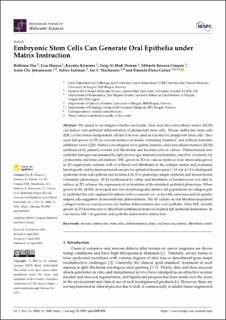Embryonic Stem Cells Can Generate Oral Epithelia under Matrix Instruction
Das, Ridhima; Harper, Lisa; Kitajima, Kayoko; Osman, Tarig Al-Hadi; Cimpan, Mihaela-Roxana; Johannessen, Anne Christine; Suliman, Salwa; Mackenzie, Ian C.; Costea, Daniela Elena
Journal article, Peer reviewed
Published version

Åpne
Permanent lenke
https://hdl.handle.net/11250/3071167Utgivelsesdato
2023Metadata
Vis full innførselSamlinger
- Department of Clinical Medicine [2047]
- Registrations from Cristin [9558]
Originalversjon
International Journal of Molecular Sciences. 2023, 24 (9), 7694. 10.3390/ijms24097694Sammendrag
We aimed to investigate whether molecular clues from the extracellular matrix (ECM) can induce oral epithelial differentiation of pluripotent stem cells. Mouse embryonic stem cells (ESC) of the feeder-independent cell line E14 were used as a model for pluripotent stem cells. They were first grown in 2D on various matrices in media containing vitamin C and without leukemia inhibitory factor (LIF). Matrices investigated were gelatin, laminin, and extracellular matrices (ECM) synthesized by primary normal oral fibroblasts and keratinocytes in culture. Differentiation into epithelial lineages was assessed by light microscopy, immunocytochemistry, and flow cytometry for cytokeratins and stem cell markers. ESC grown in 2D on various matrices were afterwards grown in 3D organotypic cultures with or without oral fibroblasts in the collagen matrix and examined histologically and by immunohistochemistry for epithelial (keratin pairs 1/10 and 4/13 to distinguish epidermal from oral epithelia and keratins 8,18,19 to phenotype simple epithelia) and mesenchymal (vimentin) phenotypes. ECM synthesized by either oral fibroblasts or keratinocytes was able to induce, in 2D cultures, the expression of cytokeratins of the stratified epithelial phenotype. When grown in 3D, all ESC developed into two morphologically distinct cell populations on collagen gels: (i) epithelial-like cells organized in islands with occasional cyst- or duct-like structures and (ii) spindle-shaped cells suggestive of mesenchymal differentiation. The 3D culture on oral fibroblast-populated collagen matrices was necessary for further differentiation into oral epithelia. Only ESC initially grown on 2D keratinocyte or fibroblast-synthesized matrices reached full epithelial maturation. In conclusion, ESC can generate oral epithelia under matrix instruction.
